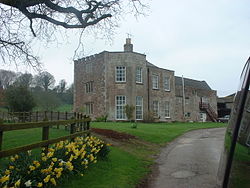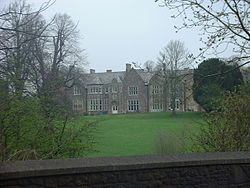Stowey
| Stowey | |
| Somerset | |
|---|---|
 Stowey House | |
| Location | |
| Grid reference: | ST597598 |
| Location: | 51°20’5"N, 2°34’46"W |
| Data | |
| Post town: | Bristol |
| Postcode: | BS39 |
| Dialling code: | 01275 |
| Local Government | |
| Council: | Bath & NE Somerset |
| Parliamentary constituency: |
North East Somerset |
Stowey is a small village and ancient parish in the Chew Hundred of Somerset, within the Chew Valley. It lies south of Chew Valley Lake and north of the Mendip Hills, approximately ten miles south of Bristol on the A368 Weston-super-Mare to Bath road. Stowey and its neighbouring and larger village, Bishop Sutton, form the civil parish of Stowey Sutton.
History
There is some evidence of a possible wooden enclosure from the Iron Age known as Stowey Castle.[1][2] There is also some evidence of an ochre crushing mill used for making pigment for marking sheep.[3]
During the 16th or 17th century, Stowey was a chapelry of Chew Magna.[4] It had become a separate parish by the 19th century, part of the hundred of Chew.[5] It became a civil parish in 1866. In 1949 the civil parish was abolished, and merged with part of the civil parish of Chew Magna to form the civil parish of Stowey Sutton.[6]
The early Lords of the Manor were the FitzRichard family. In the early 17th century it was held by the Jones family, who held it until 1840 when it was sold to Sir Edward Strachey.[4]
Folly Farm
Near to the village is Folly Farm, a 17th-century farm with traditionally managed, unimproved, neutral grassland, flowery meadows and woodlands with splendid views, run by Avon Wildlife Trust. Folly Farm includes two SSSIs — the meadows and Dowlings Wood.[7]
Landmarks
Sutton Court

Sutton Court, also known as Stowey Court, is a large house built on the site of a 14th-century castle, with sections built in the 15th and 16th century. About 1558 (former date on a fireplace) Bess of Hardwick and her second husband, Sir William St Loe, added a north-east wing with a parlour and chapel, which includes |Tudor buttresses.[8] The house was then left to her son Charles Cavendish, but later the property passed to the Strachey family.[3] From about 1650–1700 it was the seat of Richard Jones and his son Sir William Jones, the Attorney General.[9] Around 1800 it was the seat of the Strachey family including Richard Strachey and his brother John Strachey. Much of the house was remodelled in 1858 by Thomas Henry Wyatt.[8] Life at Sutton Court was described by John St. Loe Strachey in his autobiographical book The Adventure of Living in 1922.[10] It is a Grade-II* listed building.[11] A curtain wall to the north of Sutton Court with a gazebo is also listed.[12] The Lodge is also Grade II listed.[13]
Stowey House
Another significant building in the village is Stowey House to the north-west of the church, which includes original 17th-century gables, but was considerably extended in Georgian times.[3] It is a Grade II listed building.[14]
Church
The Church of St Nicholas and St Mary is a Church of England parish church, which dates back to the 15th century, when it was a chapelry of Chew Magna,[4] includes wall paintings by Henry Strachey from 1915.[8] It is a Grade-II listed building.[15]
"Stowey" is the name of a hymn tune which was adapted by Ralph Vaughan Williams for "When a Knight Won His Spurs."
References
| ("Wikimedia Commons" has material about Stowey) |
- ↑ "Stowey Castle, Stowey Sutton". Gatehouse gazetteer of the medieval fortifications and castles of England and Wales. http://www.gatehouse-gazetteer.info/English%20sites/18.html. Retrieved 25 April 2006.
- ↑ "Area 2 Chew Valley". Rural Landscapes. Bath and North East Somerset Council. http://www.bathnes.gov.uk/environmentandplanning/landandpremises/Landscape/Pages/rltarea2.aspx. Retrieved 1 January 2011.
- ↑ 3.0 3.1 3.2 Mason, Edmund J. & Mason, Doreen (1982). Avon Villages. Robert Hale Ltd. ISBN 0-7091-9585-0.
- ↑ 4.0 4.1 4.2 Robinson, W.J. (1915). West Country Churches. Bristol: Bristol Times and Mirror Ltd. pp. 206–210.
- ↑ "Somerset Hundreds". GENUKI. http://www.genuki.org.uk/big/eng/SOM/Miscellaneous/. Retrieved 8 October 2011.
- ↑ Vision of Britain website
- ↑ "Folly Farm SSSI". Natural England. http://www.english-nature.org.uk/special/sssi/sssi_details.cfm?sssi_id=1003609. Retrieved 1 January 2011.
- ↑ 8.0 8.1 8.2 Pevsner, Nikolaus (2000). The Buildings of England: North Somerset and Bristol. Penguin Books. ISBN 0-14-071013-2.
- ↑ Cruickshanks (1986). The House of Commons 1690–1715 5-Volume Set p. 527. Cambridge University Press. ISBN 0-521-77221-4.
- ↑ St. Loe Strachey, John (1922). The Adventure of Living A Subjective Autobiography (1860–1922). ISBN 1-4043-5656-8. http://www.gutenberg.org/etext/6567. Retrieved 21 May 2006.
- ↑ "Sutton Court". Images of England. Archived from the original on 30 December 2014. https://web.archive.org/web/20141230004844/http://www.imagesofengland.org.uk/Details/Default.aspx?id=32831. Retrieved 9 May 2006.
- ↑ "Curtain wall to north of Sutton Court with gazebo". Images of England. http://www.imagesofengland.org.uk/details/default.aspx?id=32832. Retrieved 9 May 2006.
- ↑ "Sutton Court Lodge". Images of England. http://www.imagesofengland.org.uk/details/default.aspx?id=32833. Retrieved 9 May 2006.
- ↑ "Stowey House". Images of England. http://www.imagesofengland.org.uk/details/default.aspx?id=32830. Retrieved 9 May 2006.
- ↑ "Church of St Nicholas and St Mary". Images of England. http://www.imagesofengland.org.uk/details/default.aspx?id=32829. Retrieved 9 May 2006.
